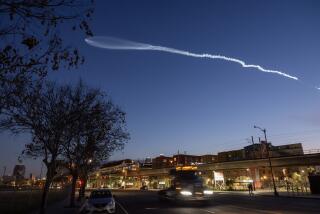Get out of Afghanistan, get into low-Earth orbit
- Share via
Research is defined as a human activity based on intellectual investigation aimed at discovering, interpreting and revising human knowledge.
None of that was provided by Paul Thornton in his recent Opinion Daily “Space program lunacy.”
What passes for research is blatant misdirection and obfuscation, laced with preconceived cynical bias from an institution that now lends credibility to tabloid-type UFO stories.
Thornton blames “NASA’s focus on manned spaceflight” and “science-fictional development” priorities of returning to the moon as causes for the failure of QuikSCAT. To boost his claim’s credibility, Thornton cites National Hurricane Center Director Bill Proenza and his public warning of “a 16% decrease in accurate hurricane forecasts should we lose the satellite without a replacement.”
But wait! QuickSCAT was a “quick recovery” mission built to replace the loss of NASA’s Scatterometer satellite in June 1997. In fact, NHC Director Proenza recently came under fire for criticizing his NOAA superiors for not replacing QuickSCAT a charge others have said Proenza overstated, unduly alarming the public and compromising the center’s credibility.
In case you missed it, I didn’t say NASA, but NOAA the National Oceanographic and Atmospheric Administration, which is responsible for operating QuickSCAT. A scientific agency of the Department of Commerce, NOAA’s stated mission is “to understand and predict changes in the Earth’s environment and conserve and manage coastal and marine resources to meet our nation’s economic, social, and environmental needs.”
NASA’s mission, on the other hand, is to “pioneer the future in space exploration, scientific discovery, and aeronautics research” all of which is clearly spelled out in the National Aeronautics and Space Act of 1958.
More important, NASA didn’t even launch QuickSCAT; it rode into orbit on a former Titan II ICBM, courtesy of the U.S. Air Force launched from right here in California at Vandenberg AFB in Santa Barbara County.
You’d think in this era of the Internet, Mr. Thornton would have been able to find a clipping about QuickSCAT’s 1999 launch in The Times’ news files.
It gets better. Thornton shows his true colors by relying on University of Maryland physics professor Robert L. Park, commonly seen in the media as an outspoken critic of manned spaceflight and “the moon-crazed Bush administration” as co-conspirators in the cancellation of NASA’s [Deep Space Climate Observatory].
Not only is Thornton particularly bad at his research, he’s terrible with economics.
In the same paragraph, he laments “NASA surviving on budgets of slightly less than $17 billion and Congress historically stingy with its space exploration purse strings despite occasional grandstanding to the contrary.” However, he shrilly complains about spending “more than $100 billion to boldly go by 2018 where we’ve already gone the geologically dead, inhospitable moon” . . . without putting into proper context what we, as Americans, spend our tax money on.
(Hint: If you read the L.A. Times, you’ve paid four times more for the newspaper than the 15 cents you spent in taxes for NASA today which has taken 49 years to spend what we’ve blown in six years on Iraq and Afghanistan since 9/11.)
Finally, Thornton’s dismissive contempt toward a “useless International Space Station” is unwarranted and premature. Despite being 60% built, ISS has managed to produce a fair amount of reportable research, including educational partnerships with this nation’s school children. I suppose Thornton would consider Starbucks coffee useless if he couldn’t get his daily decaf while the corner store was still under construction.
To be charitable, I agree with Thornton’s claim that “it’s easy to be mesmerized by the promise of deep-space exploration.” Unfortunately, “Star Trek” franchises notwithstanding, we don’t give parades to robotic spacecraft. Otherwise, we could shut down California’s tourism industry by just sending people in Peoria pictures of Disneyland, Yosemite and the beaches.
NASA’s fault is not its idealism, but that it has done relatively so much for so little. Cynics such as Thornton now expect it to do the impossible with practically nothing.
In a recent Op-Ed, Colorado educators Crystal Bloemen and Penny Glackman said space exploration “... involves programs with real-world technical challenges that students and professionals can sink their teeth into. It creates high-tech jobs and career opportunities. It points a direction for the future, motivating our youths and all humanity to dream big and literally reach for the stars.”
Jim Spellman is a chapter leader of the nonprofit National Space Society. Send us your thoughts at [email protected].
to read more about The Times’ Blowback feature.
More to Read
A cure for the common opinion
Get thought-provoking perspectives with our weekly newsletter.
You may occasionally receive promotional content from the Los Angeles Times.










